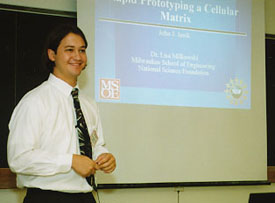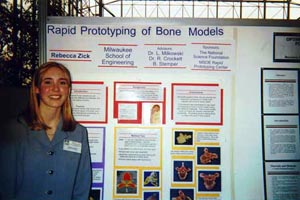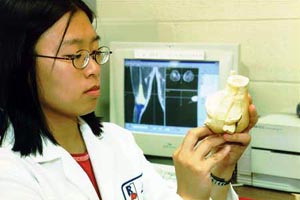![[MSOE Logo]](Biomedical-Rapid-Prototyping_bestanden/nlogo.gif) |
MSOE Home | Site Index | Contact us | Search Biomedical Engineering Applications |
|
Project Title:
|
- Sigma Xi Research Symposium, Milwaukee, Wis.
- National Conference on Undergraduate Research 2000, Missoula, Mont.
The cost of treating patients with organ or tissue failure accounts for approximately 50 percent of total annual healthcare costs in the United States. A unique solution surfacing in the medical and engineering fields is designing and growing individual tissue. The objective of this research was to apply rapid prototyping technology in the construction of a 3-D matrix for cellular ingrowth. Rapid prototyping is a manufacturing technique that creates various 3-D geometries by means of layer-by-layer construction. Three methodologies for building a cellular matrix utilizing rapid prototyping will be presented. The Differentiated Method utilizes a mold from a secondary rapid prototyping process. The growth of cells is dependent on the negative space created by the sintering of the biomaterial in the mold. The Non-Sintering Method is similar to the Differentiated Method, except that the material is not sintered. The Homogeneous Method physically creates the microstructures that will deliver necessary elements and get rid of waste. This method models the transferring of the materials in the capillaries of humans. The Differentiated Method has shown the most promise in its construction providing pathways for the ingrowth of cells.
Note:
John Janik, Lisa Milkowski and Vito Gervasi filed an Invention
Disclosure with the U.S. Patent and Trademark Office entitled "Phantom
Lattice" on August 6, 1999.
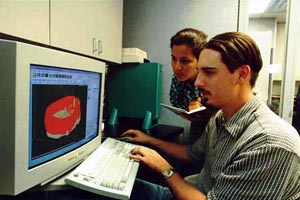 |
| "This REU program
really opened my eyes to the world of rapid prototyping."
--Veronica Ramos, Texas
A&M-Kingsville, --Brian Stemper, Milwaukee School of Engineering |
- Medical Applications Of Rapid Prototyping
- Veronica Ramos, Junior, Industrial Engineering, Texas
A&M-Kingsville, Kingsville, Texas
Brian Stemper, Senior, Biomedical Engineering, Milwaukee School of Engineering
- Biomedical Engineering
- Darius Daruwala
- Argonne National Laboratory Undergraduate Research Symposium, Chicago, Ill.
Project objectives were to: compile information on current medical applications of rapid prototyping technology; become familiar with a new computer software package that interface medicine and rapid prototyping; and create three-dimensional anatomical models using specialized software and rapid prototyping techniques. Information gathered from articles, journals, interviews, and companies have been logged and compiled and is now housed in the MSOE Rapid Prototyping Center's library. The specialized software was mastered and was used to create tow unique anatomical three-dimensional models from CT scans. The two models were then created using fused deposition modeling and stereolithography. Three general conclusions have been drawn. First, that the three-dimensional clarity that is found in a rapid prototyping model decreases potential miscommunication among medical professionals. The second conclusion is that the hands-on experience that a three-dimensional model provides is thus far unmatched by three-dimensional computer models and CT studies. Finally, rapid prototyping produces more confidence for surgeons by reducing the number of unknowns in the surgical theater.
 |
|
--Kerstin Ollison, Milwaukee School of Engineering |
- Biomedical Applications Of Rapid Prototyping
- Kerstin Ollison, Junior, Biomedical Engineering, Milwaukee School of
Engineering
- Biomedical Engineering
- Darius Daruwala and Dr. Bob Crockett
Abstract not available
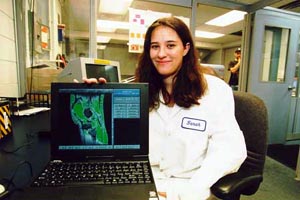 |
| "I enjoyed the
opportunity to work with new and exciting technology."
--Sarah Vickman, Milwaukee School of Engineering |
- Rapid Prototyping And Segmentation Of MRI Images
- Sarah Vickman, Senior, Biomedical Engineering, Milwaukee School of
Engineering
- Biomedical Engineering
- Dr. Lisa Milkowski
- National Conference on Undergraduate Research '99, Rochester, N.Y.; paper published in conference proceedings
- IEEE- Milwaukee Chapter, Milwaukee, Wis.
3-D models of medical images are helpful tools used in surgical planning and as teaching aids. Currently, there is no cost-effective method of constructing these 3-D models from MRI scans, because scans are not homogenous. The objective is to segment the tissue in MRI scans. Computer software based on the K-mean algorithm can distinguish the pixel values of anatomical structures in medical images. This computer software was tested and a procedure was developed for testing different algorithms. Based on the results of the testing, the K-mean algorithm shows potential for improved selection of tissue.
|
Project Title:
|
- National Conference on Undergraduate Research '99, Rochester, N.Y.; paper published in conference proceedings
- IEEE- Milwaukee Chapter, Milwaukee, Wis.
- International Conference on Mathematical & Computer Modeling, Chicago, Ill.
The mechanical properties of bone are a unique combination of material and structure. Current models of bone show the exterior geometry, but none illustrate the interior structure. Therefore, these models do not fully represent the mechanical properties of bone. The objective of this project is to build a physical model of a bone that possesses the same mechanical properties as real bone. Rapid prototyping technology, together with medical images, could be used to build accurate composite models of bone, having different materials in distinct areas of the bone. This project focused on developing a technique for building composite models.
 |
| "This program gave me
confidence in my ability to start something I know absolutely
nothing about, make sense of it and a create a solution."
--Thomas C. Hanks, Milwaukee School of Engineering |
- The Application Of Rapid Prototyping To Replicate The Human
Intervertebral Disc
- Thomas C. Hanks, Junior, Mechanical Engineering, Milwaukee School of
Engineering
- Biomedical Engineering
- Dr. Lisa Milkowski
- National Conference on Undergraduate Research 2000, Missoula, Mont.
The ultimate goal of this research project is to create a model of the human intervertebral disc that replicates the geometric and mechanical properties. An accurate model of the intervertebral disc has a wide range of applications including a better understanding of the mechanical behavior of the intervertebral disc. To date, the geometry of the intervertebral disc was obtained using computed tomography images and the mechanical properties were obtained from previous research done on different areas of the intervertebral disc. A mostly hollow structure comprised of small, varying sized chambers was designed and built using rapid prototyping technology, or the creation of three- dimensional structures one layer at a time by means of selective solidification. In addition, a method of filling individual chambers of the structure with different materials was developed. It is expected that by varying the relative size of these chambers, and the material that occupies it, the properties at each location will be varied and a highly anisotropic structure similar to the human intervertebral disc would be created.
|
Project Title:
|
- Dr. Lisa Milkowski
The knee is a complex joint even though it is considered rather simple. It has a moving center of rotation due to the shape of the bones and the ligaments. Rapid prototyping technology and medical images will be used to create a functional model that illustrates this moving point and anatomical characteristics. This has immediate benefits in education. With a 3-D digitizer capturing external data about a patient's injured knee, computer software can analyze the center of rotation in the patient's knee. Understanding and modeling the motion of the center of rotation in both the analysis of the patient's knee as well a function model will be beneficial in designing a custom orthotic for the patient.
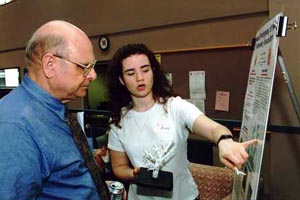 |
| "I gained the knowledge
that by working with people from different fields you gain a higher
understanding and a better solution to your own project."
--Amy Andreae, Milwaukee School of Engineering |
- Rapid Prototyping of the Lung Vasculature
- Amy Andreae, Junior, Biomedical Engineering, Milwaukee School of
Engineering
- Biomedical Engineering
- Dr. Lisa Milkowski
- IEEE Symposium, Racine, Wis.
- Sigma Xi Poster Symposium 2001, Milwaukee, Wis.
Accurate physical models of the pulmonary circulatory system may be useful in understanding more about pulmonary function and the effects caused by drug, age or environmental changes. Vasculature casting, the current method of creating a physical model of the lung vasculature, provides a geometric model but is incapable of simulating flow or being reproduced. By incorporating medical imaging and rapid prototyping, it is possible to create scaleable, flow-through models of the lung vasculature. Medical images of a rat lung were converted into a solid rendering using Mimics software and fabricated on a rapid prototyping machine. A Selective Laser Sintering (SLS) machine was employed for the construction. The SLS machine creates three-dimensional parts, from powder is fused using a CO2 laser. The pulmonary model was placed in an enclosure that will replicate the lung boundary. To complete the physical circuit, the capillary bed was simulated with packed powder in the vacant spaces of the enclosure. The powder was sized to imitate the resistance of the capillary bed. Flow simulation will ensure that overall flow and pressure characteristics are concurrent with previous scientific findings. The presented methods demonstrate that physical, flow-through models of biological vasculature may be efficiently produced using non-invasive techniques and may be a new tool for studying lung hemodynamics.
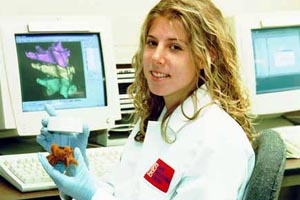 |
| I'm a better presenter
and have a lot more interest in biomechanics."
--Marie Kluge, Milwaukee School of Engineering |
- Rapid Prototyping the Intervertebral Disc
- Marie Kluge, Junior, Biomedical Engineering, Milwaukee School of
Engineering
- Biomedical Engineering
- Dr. Lisa Milkowski
- Sigma Xi Poster Symposium 2000, Milwaukee, Wis.
- National Conference on Undergraduate Research 2001; paper published in conference proceedings.
Currently there is a need for an accurate model of the intervertebral disc for correcting aged, deteriorated, or damaged discs. The existing methods for modeling the spine such as in vitro, in vivo and mathematical models have high variability. This paper proposes a technique to create a mechanically analogous physical model of an intervertebral disc. The non-homogeneous structured disc would characterize both the geometric and the mechanical properties having an incompressible fluid center and a fibrous tissue outer layer. The process starts with a medical computed tomography image. The image would then be converted into an acceptable rapid prototyping format. Once a three dimensional and geometrically accurate object has been created, a secondary process such as molding is necessary to acquire the precise materials for modeling the mechanical properties. Rapid Prototyping provides the ability to design the disc to uniquely represent various ages or diseased discs. This model may be an invaluable asset to research and the medical field as an accurate model, as a unique tool, and as a possible place to start for intervertebral disc implants.
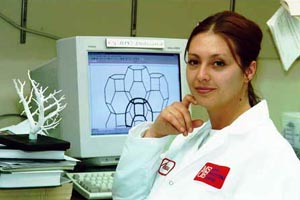 |
| "Invaluable experience
for undergraduate exposure to research before graduation."
--Andrea Pedone, Milwaukee School of Engineering |
- Rapid Prototyping the Lung Vasculature
- Andrea Pedone, Senior, Biomedical Engineering, Milwaukee School of
Engineering
- Biomedical Engineering
- Dr. Lisa Milkowski
- Sigma Xi Poster Symposium 2000, Milwaukee, Wis.
The relationship between the arteries, veins and capillaries in the lungs are of great importance in understanding the pulmonary circulatory system. This circulatory system refers to the flow of deoxygenated blood from the heart to the lungs for reoxygenation and the return of oxygenated blood from the lungs back to the heart. A physical model of the pulmonary vasculature could lead to many useful discoveries and knowledge. Current methods of modeling the lung vasculature are casting and mathematical modeling. These offer only a purely geometric solution and are incapable of being duplicated or simulating flow. These obstacles could be overcome by creating a flow through model of lung vasculature using rapid prototyping. By integrating non-invasive medical images with the techniques of rapid prototyping, the flow through model can be created. In addition, the use of rapid prototyping materials and sensors to simulate the vessels and overall characteristics of the lungs and blood will be incorporated. The creation of the flow through model of the lung vasculature may provide a new tool of studying hemodynamic variables and pathology of the lung. It may also improve the simulation of mechanical properties of the lung and vasculature.
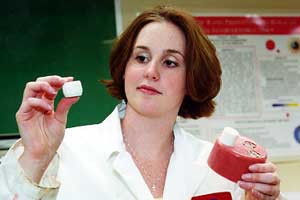 |
| "I'm much more excited
about my field and the possibilities for research."
--Kim Spurgeon, Milwaukee School of Engineering |
- Mechanical Modeling of Bone
- Kim Spurgeon, Junior, Biomedical Engineering, Milwaukee School of
Engineering
- Biomedical Engineering
- Dr. Lisa Milkowski
- 12th Annual Argonne National Laboratory Symposium for Undergraduates in Science, Engineering and Mathematics, Argonne, Ill.
- Sigma Xi Poster Symposium 2001, Milwaukee, Wis.
This paper presents a methodology for using Rapid Prototyping to produce mechanical models of the two major regions of bone, cortical and trabecular. Current models, such as vertebral, represent the geometry, but not the mechanical properties of human anatomy. This mechanically accurate model will allow for testing the efficiency of surgical devices on a more realistic model. The tetralattice structure was ideal for creating mechanical models because it creates a gradient of materials. This technique achieves a range of mechanical properties to allow representation of normal and diseased anatomy. Several rapid prototyping and filler materials were mechanically tested to find the stress-strain curve. The materials that best match that of cortical bone are Somos 201 and a Zirconium Silicate Ceramic with moduli of 2.285 and 8.377 ksi, respectively. None of the materials tested represent the modulus of trabecuar bone. Results from mechanical testing of materials are presented. This shows that it is possible to mechanically model bone using rapid prototyping techniques.
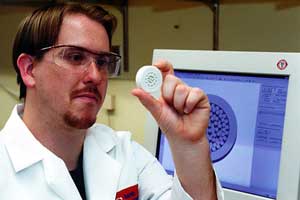 |
| "I loved the
interdisciplinary nature of the program. It opened my eyes to how
engineers with different backgrounds can be helpful in showing me a
new approach."
--Paul Clark, Milwaukee School of Engineering |
- Rapid Prototyping the Intervertebral Disc Using Structural
Analysis
- Paul Clark, Senior, Biomedical Engineering, Milwaukee School of
Engineering
- Biomedical Engineering
- Dr. Lisa Milkowski
- 12th Annual Argonne National Laboratory Symposium for Undergraduates in Science, Engineering and Mathematics, Argonne, Ill.
The ability to model mechanical properties of complex structures could have many important implications. Specifically in the medical field where tissues display complex properties, simple and accurate models could assist in biomedical product testing and research.
An intervertebral disc (IVD) is located between every two vertebra of the spine and acts as a shock absorber for the body. No physical current models exist that accurately model the IVD’s non-homogenous mechanical properties. This paper proposes a method of modeling the IVD using rapid prototyping.
By combining structural analysis and the mechanical properties of rapid prototyping materials, complex internal geometries can be formed such that the resultant model of the IVD will have the same structural response as the actual IVD. Rapid prototyping provides the ability to precisely place these complex geometries and patterns. The resulting rapid-prototyped model of the IVD could be an invaluable model in biomedical testing and research of the spine.
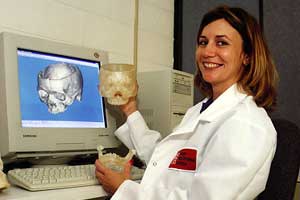 |
| "I enjoyed the unique
relationships and team work that were developed with other
participants."
--Deborah Jaye, Marquette University |
- Determining the Accuracy of Replicating the Human Skull with Rapid
Prototyping
- Deborah Jaye, Senior, Biomedical Engineering, Marquette
University
- Biomedical Engineering
- Dr. Lisa Milkowski
- Rockwell Automation, Milwaukee, Wis.
- Sigma Xi Poster Symposium 2001, Milwaukee, Wis.
Physical models of the human skull or parts thereof are currently being used in many applications including presurgical planning, creation of custom implants, and forensic/criminal analysis. Accuracy is essential for each of these applications, yet few studies have been done to determine the accuracy of the replication process. The process consists of acquisition of a computed tomography (CT) image of the original skull, image processing to convert from CT images to a three-dimensional virtual model, and building of the virtual model with Rapid Prototyping (RP) to create the physical model. The difference in linear measurements between the original skull and physical model is determined using an automated Coordinate Measuring Machine (CMM). Past studies have revealed that the variables of CT scan acquisition have been the most limiting factor in attaining high levels of accuracy and that the effects of those variables need to be examined. This research project compares the accuracy of the replication process to the results from other studies. The mean dimensional accuracy of 99.02% achieved in this study is an improvement from past studies. In addition, this study explores the impact of various CT parameters on overall accuracy.
 |
| "I really liked the
opportunity to be creative and be taken seriously. It's hard as an
undergraduate to be given that freedom."
--Christine Litoborski, Ripon College |
- Single-Use Impact Force Sensor
- Christine Litoborski, Junior, Physics and Education, Ripon
College
- Biomedical Engineering
- Dr. Larry Fennigkoh
- Wisconsin Physics Teachers Conference, Stevens Point, Wis.
Solid Freeform Fabrication (SFF) has allowed for the creation of intricate parts with great accuracy and precision. The goal of this research has been to use SFF to develop a method of measuring the peak impact force and the area covered by that force without the use of complicated instrumentation. This information can be used to obtain a reasonable assessment of structural weakness in bicycle helmets. The sensor must be constructed such that the device does not interfere with the normal interaction of the object and its surroundings, so that it can be used outside of the laboratory in real-life situations. Therefore, there cannot be wiring to external power sources or meters. The force sensor created in this project relies on the failure of columns within the sensor. The buckling force used to calculate the strength of the columns depends on the elasticity of the structural material, the length and radius of the columns, and how the columns are affixed. Because ideally this sensor needs to be very small to be inserted into a helmet, SFF’s small resolution plays an integral role in accurately producing columns that are very small and slender.
Project Title:
- Effects of CT Scanner Collimation on the Accuracy of Models Produced
by Rapid Prototyping
- Andrew Jaczynski, Junior, Biomedical Engineering, Milwaukee School
of Engineering
- Biomedical Engineering
- Dr. Larry Fennigkoh
Accuracy is of the utmost importance when using data acquired from a computed tomography (CT) image to create a model using rapid prototyping (RP). Previous studies have indicated that the collimation, or slice thickness of the CT scanner has a correlation with accuracy. The purpose of this research was to statistically test the effect of several different collimation settings on the X, Y, and Z planes of a RP model created using a phantom. A phantom is a precisely machined object designed specifically for testing the accuracy and resolution of imaging devices. Four CT images were created at collimations of 1mm, 3mm, 5mm, and 10mm. The images were converted into a three-dimensional rapid prototype friendly format from which four models were created. These models were measured using readily available tools including micrometers and calipers. This data was compared against the original dimensions of the phantom using a two-way repeated measure ANOVA. This research could be beneficial towards the creation of accurate anatomical models using rapid prototyping technology.
© 2002 Milwaukee School of Engineering
